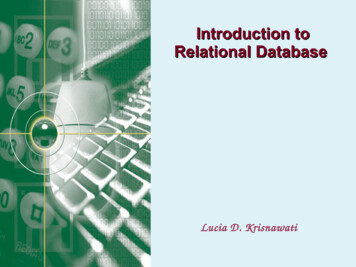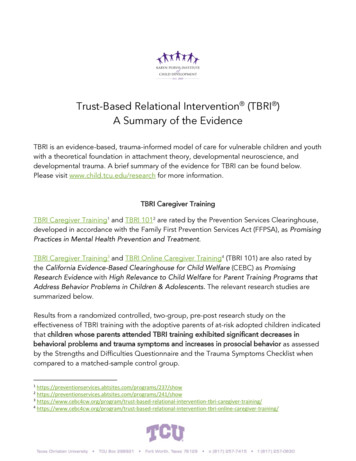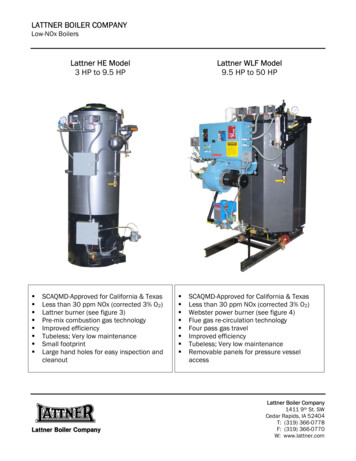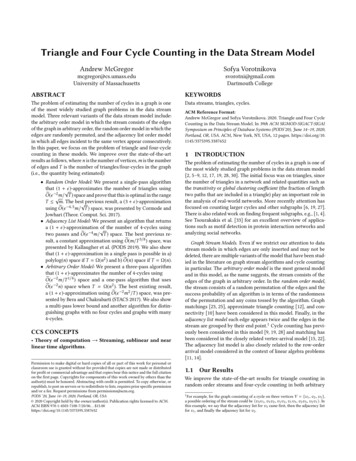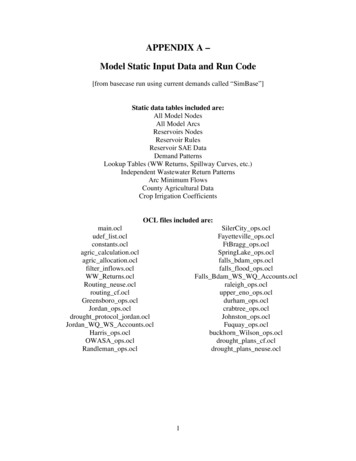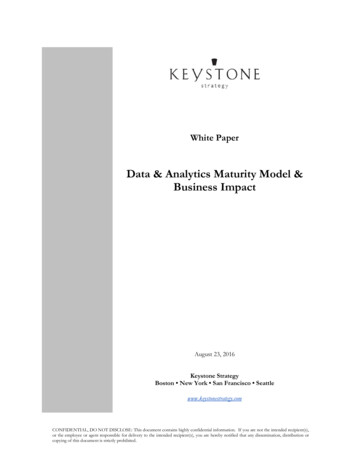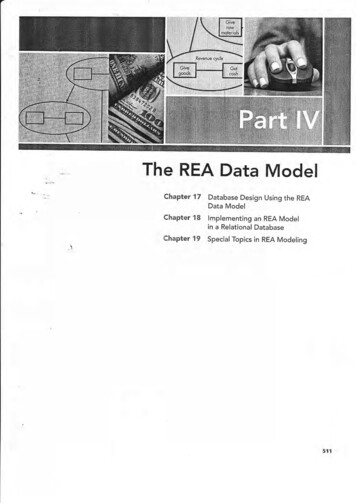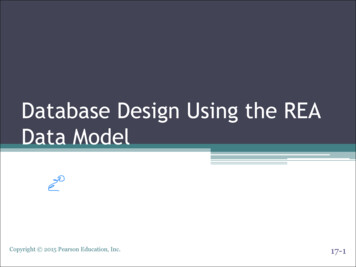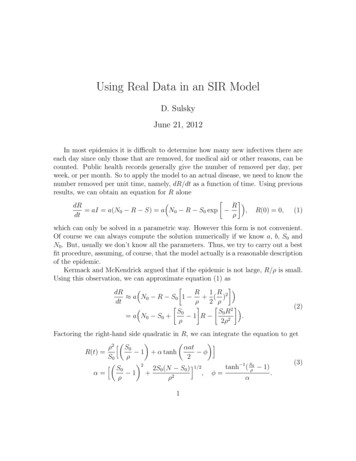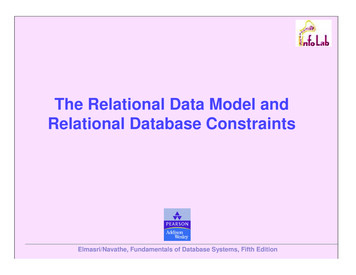
Transcription
The Relational Data Model andRelational Database ConstraintsElmasri/Navathe, Fundamentals of Database Systems, Fifth Edition
Chapter Outline Relational Model Concepts Relational Model Constraints and RelationalDatabase Schemas Update Operations and Dealing with ConstraintViolationsElmasri/Navathe, Fundamentals of Database Systems, Fifth Edition2
Relational Model Concepts The relational Model of Data is based on theconcept of a Relation. The model was first proposed by Dr. T.F.Codd of IBM in 1970 in the following paper:"A Relational Model for Large Shared DataBanks," Communications of the ACM, June1970.The above paper caused a major revolution in thefield of Database management and earned Ted Coddthe coveted ACM Turing Award.Elmasri/Navathe, Fundamentals of Database Systems, Fifth Edition3
Informal Definitions RELATION: A table of values– A relation may be thought of as a set of rows.– Each row represents a fact that corresponds to areal-world entity or relationship.– Each row has a value of an item or set of items thatuniquely identifies that row in the table.– Each column typically is called by its column nameor column header or attribute name.Elmasri/Navathe, Fundamentals of Database Systems, Fifth Edition4
Informal Definitions Key of a Relation:– Each row has a value of a data item (or set of items)that uniquely identifies that row in the table Called the key– In the STUDENT table, SSN is the key– Sometimes row-ids or sequential numbers areassigned as keys to identify the rows in a table Called artificial key or surrogate keyElmasri/Navathe, Fundamentals of Database Systems, Fifth Edition5
Example - Figure5.1Elmasri/Navathe, Fundamentals of Database Systems, Fifth Edition6
Formal definitions The Schema (or description) of a Relation:– Denoted by R(A1, A2, .An)– R is the name of the relation– The attributes of the relation are A1, A2, ., An Example:CUSTOMER (Cust-id, Cust-name, Address, Phone#)– CUSTOMER is the relation name– Defined over the four attributes: Cust-id, Cust-name, Address,Phone# Each attribute has a domain or a set of validvalues.– For example, the domain of Cust-id is 6 digitnumbers.Elmasri/Navathe, Fundamentals of Database Systems, Fifth Edition7
Formal definitions A row is called a tuple, which is an ordered set of values A column header is called an attribute– Each attribute value is derived from an appropriate domain. The table is called a relation.– A relation can be regarded as a set of tuples (rows). The data type describing the types of values an attributecan have is represented by a domain of possible values. Each row in the CUSTOMER table is a 4-tuple andconsists of four values, for example. 632895, "John Smith", "101 Main St. Atlanta, GA 30332","(404) 894-2000" A relation is a set of such tuples (rows).Elmasri/Navathe, Fundamentals of Database Systems, Fifth Edition8
Formal Definitions A domain has a logical definition.Example: “USA phone numbers” are the set of 10 digitphone numbers valid in the U.S. A domain also has a data-type or a formatdefined for it.– For example, the USA phone numbers may have aformat: (ddd)-ddd-dddd where each d is a decimaldigit.– Dates have various formats such as month, date,year or yyyy-mm-dd, or dd mm,yyyy etc.Elmasri/Navathe, Fundamentals of Database Systems, Fifth Edition9
Formal Definitions The relation is formed over the cartesian product ofthe sets; each set has values from a domain The Cartesian product of two sets A and B is definedto be the set of all pairs (a, b) where a A and b B . Itis denoted A B , and is called the Cartesian productElmasri/Navathe, Fundamentals of Database Systems, Fifth Edition10
An Example of Cartesian ProductRSABXYa1b1x1y1a2b2x2y2RR x1y1a2b2x2y2a2b2x2y2ABCElmasri/Navathe, Fundamentals of Database Systems, Fifth EditionD11
An Example of Cartesian ProductSTUDENTENROLLMENTSIDSNameC NOSID111Williams1000111222Johnes2000222STUDENT ENROLLMENTSTUDENTENROLLMENTRESULTSNameC NOSID111Williams1000111111Williams 1000111111Williams2000222111Williams 22222Johns2000222SIDSIDSNameC NOElmasri/Navathe, Fundamentals of Database Systems, Fifth EditionSID12
Formal Definitions The degree of a relation is the number ofattributes n of its relation schema. A relation schema R of degree n is denotedbyR(A1 , A2 , , An ) The domain of Ai is denoted by dom(Ai).Elmasri/Navathe, Fundamentals of Database Systems, Fifth Edition13
DEFINITION SUMMARYInformal TermsFormal lues in a columnDomainTable DefinitionSchema of a RelationPopulated TableExtensionElmasri/Navathe, Fundamentals of Database Systems, Fifth Edition14
Characteristics of Relations Ordering of tuples in a relation r(R):– The tuples are not considered to be ordered, eventhough they appear to be in the tabular form. Ordering of attributes in a relation schemaR (and of values within each tuple):– We will consider the attributes in R(A1, A2, ., An)and the values in t v1, v2, ., vn to be ordered . Values in a tuple: All values are considered atomic(indivisible). A special null value is used to representvalues that are unknown or inapplicable to certaintuples.Elmasri/Navathe, Fundamentals of Database Systems, Fifth Edition15
CHARACTERISTICS OF RELATIONS- Figure 5.2Elmasri/Navathe, Fundamentals of Database Systems, Fifth Edition16
Relational Integrity Constraints Constraints are conditions that must hold on allvalid relation states. There are three main types of constraints in therelational model:– Key constraints– Entity integrity constraints– Referential integrity constraints Another implicit constraint is the domain constraint– Every value in a tuple must be from the domain of itsattribute (or it could be null, if allowed for thatattribute)Elmasri/Navathe, Fundamentals of Database Systems, Fifth Edition17
Key Constraints Superkey of R: Is a set of attributes SK of R with thefollowing condition:– No two tuples in any valid relation state r(R) will have thesame value for SK– That is, for any distinct tuples t1 and t2 in r(R), t1[SK] t2[SK]– This condition must hold in any valid state r(R) Key of R:– A "minimal" superkey– That is, a key is a superkey K such that removal ofany attribute from K results in a set of attributes that isnot a superkey (does not possess the superkeyuniqueness property)Elmasri/Navathe, Fundamentals of Database Systems, Fifth Edition18
Key Constraints (continued) Example: Consider the CAR relation schema:CAR(State, Reg#, SerialNo, Make, Model, Year)– CAR has two keys:Key1 {State, Reg#}Key2 {SerialNo}– Both are also superkeys of CAR– {SerialNo, Make} is a superkey but not a key. In general:– Any key is a superkey (but not vice versa)– Any set of attributes that includes a key is a superkey– A minimal superkey is also a keyElmasri/Navathe, Fundamentals of Database Systems, Fifth Edition19
Key Constraints (continued) If a relation has several candidate keys, one is chosenarbitrarily to be the primary key.– The primary key attributes are underlined. Example: Consider the CAR relation schema:CAR(State, Reg#, SerialNo, Make, Model, Year)We chose SerialNo as the primary key The primary key value is used to uniquely identify eachtuple in a relation and provides the tuple identity Also used to reference the tuple from another tuple– General rule: Choose as primary key the smallest ofthe candidate keys (in terms of size)– Not always applicable – choice is sometimessubjectiveElmasri/Navathe, Fundamentals of Database Systems, Fifth Edition20
CAR table with two candidate keys –LicenseNumber chosen as Primary KeyElmasri/Navathe, Fundamentals of Database Systems, Fifth Edition21
Relational Databases andRelational Database Schemas Relational Database Schema:– A set S of relation schemas that belong to the samedatabase.– S is the name of the whole database schema– S {R1, R2, ., Rn}– R1, R2, , Rn are the names of the individualrelation schemas within the database S Following slide shows a COMPANY database schemawith 6 relation schemasElmasri/Navathe, Fundamentals of Database Systems, Fifth Edition22
Schema Diagram for the COMPANYRelational Database SchemaElmasri/Navathe, Fundamentals of Database Systems, Fifth Edition23
Figure 5.6 One possible database state for the COMPANYrelational database schemaElmasri/Navathe, Fundamentals of Database Systems, Fifth Edition24
Entity Integrity Entity Integrity:– The primary key attributes PK of each relationschema R in S cannot have null values in anytuple of r(R). This is because primary key values are used to identifythe individual tuples. t[PK] null for any tuple t in r(R) If PK has several attributes, null is not allowed in any ofthese attributes– Note: Other attributes of R may be constrained todisallow null values, even though they are notmembers of the primary key.Elmasri/Navathe, Fundamentals of Database Systems, Fifth Edition25
Referential Integrity A constraint involving two relations. Used to specify a relationship among tuples in tworelations: the referencing relation and thereferenced relation. Tuples in the referencing relation R1 have attributesFK (called foreign key attributes) that reference theprimary key attributes PK of the referenced relationR2. A tuple t1 in R1 is said to reference a tuple t2 in R2if t1[FK] t2[PK]. A referential integrity constraint can be displayed in arelational database schema as a directed arc fromR1.FK to R2.PKElmasri/Navathe, Fundamentals of Database Systems, Fifth Edition26
Displaying a relational databaseschema and its constraints Each relation schema can be displayed as a row ofattribute names The name of the relation is written above the attributenames The primary key attribute (or attributes) will beunderlined A foreign key (referential integrity) constraints isdisplayed as a directed arc (arrow) from the foreign keyattributes to the referenced table– Can also point the primary key of the referencedrelation for clarity Next slide shows the COMPANY relational schemadiagramElmasri/Navathe, Fundamentals of Database Systems, Fifth Edition27
Elmasri/Navathe, Fundamentals of Database Systems, Fifth Edition28
Referential Integrity Constraint The value in the foreign key column (or columns) FK ofthe referencing relation R1 can be either:1) a value of an existing primary key value of acorresponding primary key PK in the referenced relationR2, or2) a null. In case (2), the FK in R1 should not be a part of its ownprimary key.Example: "John”, “L”,, “Smith", 111222333, 1965-10-21, "101 Main St.Atlanta, GA 30332", M, 42000, 444555666, NULL “Mary”, “J”,, “Burton", 111111111, 1972-1-18, “23 Maple St.Atlanta, GA 30310", F, 35000, NULL, 3 Elmasri/Navathe, Fundamentals of Database Systems, Fifth Edition29
Other Types of Constraints Semantic Integrity Constraints:– based on application semantics and cannot beexpressed by the model per se– Example: “the max. no. of hours per employee for allprojects he or she works on is 56 hrs per week” A constraint specification language may haveto be used to express these SQL-99 allows triggers and ASSERTIONS toexpress for some of theseElmasri/Navathe, Fundamentals of Database Systems, Fifth Edition30
Populated database state Each relation will have many tuples in its currentrelation state The relational database state is a union of all theindividual relation states Whenever the database is changed, a new statearises Basic operations for changing the database:– INSERT a new tuple in a relation– DELETE an existing tuple from a relation– MODIFY an attribute of an existing tuple Next slide shows an example state for theCOMPANY databaseElmasri/Navathe, Fundamentals of Database Systems, Fifth Edition31
Populated database state for COMPANYElmasri/Navathe, Fundamentals of Database Systems, Fifth Edition32
Update Operations on Relations INSERT a tuple.DELETE a tuple.MODIFY a tuple.Integrity constraints should not be violated by the updateoperations. Several update operations may have to be groupedtogether. Updates may propagate to cause other updatesautomatically. This may be necessary to maintainintegrity constraints.Elmasri/Navathe, Fundamentals of Database Systems, Fifth Edition33
Update Operations on Relations In case of integrity violation, several actions canbe taken:– Cancel the operation that causes the violation(RESTRICT or REJECT option)– Perform the operation but inform the user of theviolation– Trigger additional updates so the violation iscorrected (CASCADE option, SET NULL option)– Execute a user-specified error-correction routineElmasri/Navathe, Fundamentals of Database Systems, Fifth Edition34
Possible violations for each operation INSERT may violate any of the constraints:– Domain constraint: if one of the attribute values provided for the new tuple is notof the specified attribute domain– Key constraint: if the value of a key attribute in the new tuple already existsin another tuple in the relation– Referential integrity: if a foreign key value in the new tuple references a primarykey value that does not exist in the referenced relation– Entity integrity: if the primary key value is null in the new tupleElmasri/Navathe, Fundamentals of Database Systems, Fifth Edition35
Possible violations for each operation DELETE may violate only referential integrity:– If the primary key value of the tuple being deleted isreferenced from other tuples in the database Can be remedied by several actions: RESTRICT,CASCADE, SET NULL (see Chapter 8 for more details)– RESTRICT option: reject the deletion– CASCADE option: propagate the new primary key valueinto the foreign keys of the referencing tuples– SET NULL option: set the foreign keys of the referencingtuples to NULL– One of the above options m
"A Relational Model for Large Shared Data Banks," Communications of the ACM, June 1970. The above paper caused a major revolution in the field of Database management and earned Ted Codd the coveted ACM Turing Award. Elmasri/Navathe, Fundamentals of Database Systems, Fifth Edition 4 Informal Definitions RELATION: A table of values – A relation may be thought of as a set of rows. – Each .
